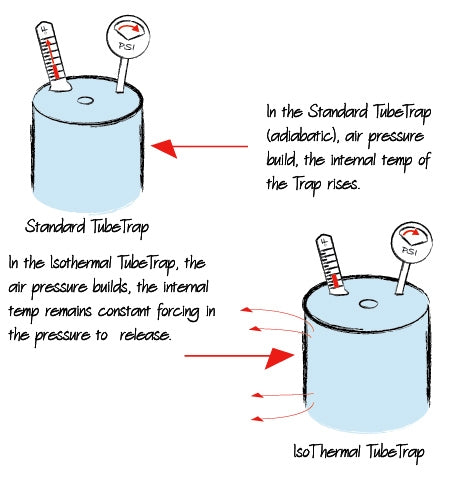How IsoThermal TubeTraps Create Better Sound For You
The new ASC IsoThermal TubeTrap is a self contained broadband acoustic absorber/diffuser. It works by utilizing a reactive acoustic circuit that is powered by the sound pressure in your room.
Like all of our TubeTrap line, the IsoThermal works best where the sound pressure is the strongest, which is in the corners and against the walls in your room. IsoThermal TubeTraps are an improved TubeTrap that provides double absorbing power in the sub-bass range, below 60Hz and enhanced bass absorption up through middle C, or 260Hz.
The IsoThermal TubeTrap includes the traditional, built in treble range diffuser to back scatter and diffuse the upper treble range back into the room and to also enhance development of fine-grained lateral ambience in the room.
Combined with the extended and doubled low-frequency absorption range, the new ASC IsoThermal TubeTrap is the perfect upgrade to your high-end audio system because it helps get your listening room out of the way of your listening experience.
We developed the IsoThermal TubeTrap to aggressively manage typical HiFi rear wall bounce phase-cancel effects. What we got was a major performance boost across the entire bass spectrum. And we did it without altering the fundamental voice of a TubeTrap.

Check out the absorption data for the new 16″ Isothermal TubeTrap compared to a standard 16″ TubeTrap. Power is doubled in the sub-bass range, while the LF rolloff is extended by over half an octave! The efficiency of the unit is a solid 40% greater all the way up through the “muddy” range of bass.
We were even more impressed when third party theoretical calculations made in ESI’s NOVA software (a multi layered acoustic simulator used in advanced acoustic engineering) corroborated our data to an uncanny degree.

As with standard TubeTraps, larger diameter units reach to lower frequencies. However, with the IsoThermal upgrade, the operating frequency of each size TubeTrap has come to match that of the next model size larger, approximately. This means that if you previously used and loved the sonics of a 16″ TubeTrap, you can now replace your old tubes with new 13″ IsoThermal TubeTraps, with very similar voicing. Better yet, if you always wished you had the space in your room and money in your wallet to fill your corners with deep-breathing 20″ TubeTraps, now you can simply upgrade your system with 16″ IsoThermal TubeTraps to manage that 35 Hz rumble.
What is the IsoThermal effect? The short story begins with the statement that when you compress gas, it heats up, while when it expands, it cools down. High pressure sounds entering the acoustic capacitor of a TubeTrap cause a rise in pressure, or compression. When the air pressure inside the TubeTrap reaches that of the ambient air outside it, the capacitor is essentially “full.” The air then cools off fairly rapidly due to thermal and hydraulic losses, and returns to low pressure, ready to be filled up again.
The frequency of this “filling-up” is proportional to – you guessed it – the frequency of the sound. Therefore low frequency sounds “fill up” the capacitor much more quickly, due to the slowness with which they propagate through the media. A larger capacitor (think of a 24″ TubeTrap) takes the longest to fill, and so reaches the lowest frequencies.
The conversion of the capacitive section of a TubeTrap into an isothermal vessel alters this behavior in a very beneficial way. The low-pressure air inside the capacitor is prevented from rising in temperature upon being subjected to a high-pressure pulse. Through this action, the effective size of the capacitor is increased by 40%, almost as though the IsoThermal TubeTrap is 40% larger than it appears! (This comparison is not quite accurate, since other factors come into play regarding the resistance of the absorptive material among various TubeTrap models, but it is a good approximation).

























